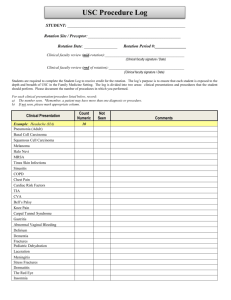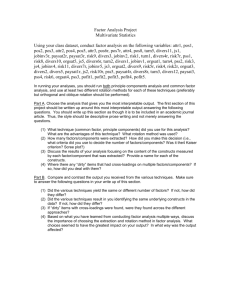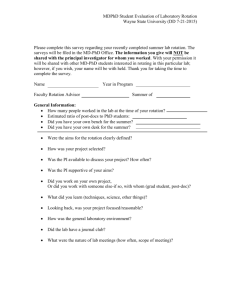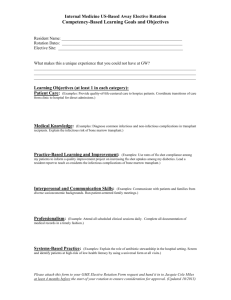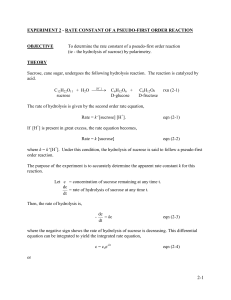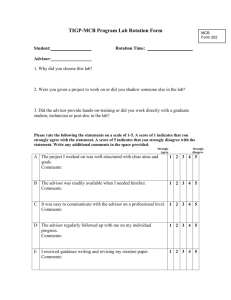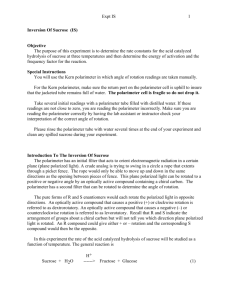This procedure is applicable for the Polarimeter
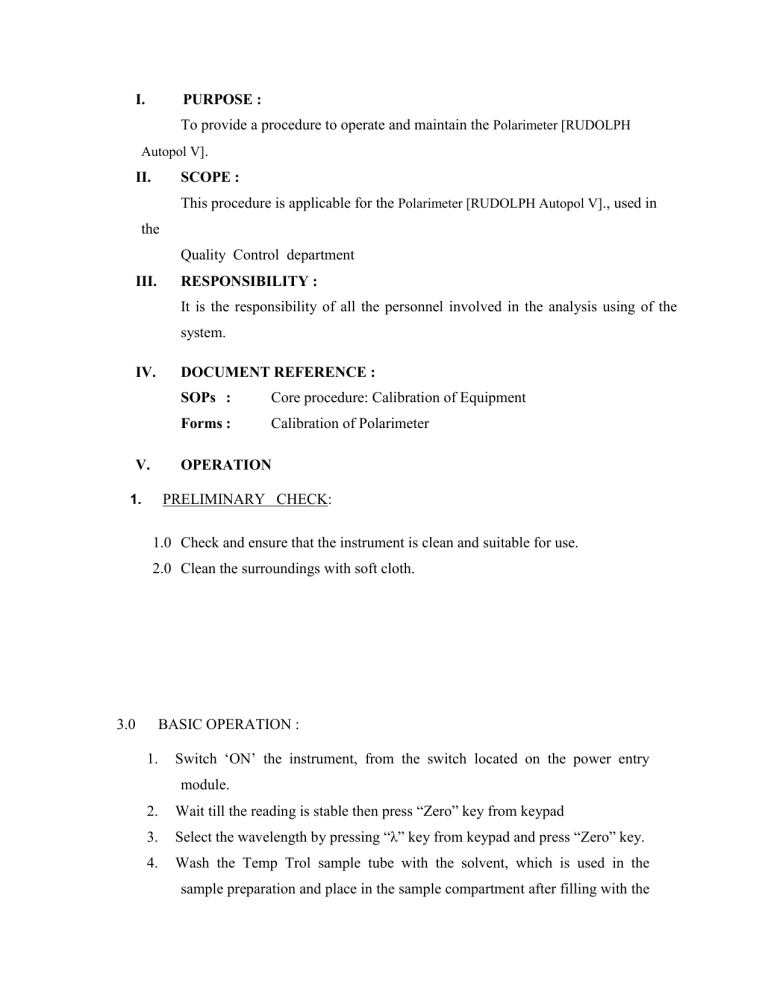
I. PURPOSE :
To provide a procedure to operate and maintain the Polarimeter [RUDOLPH
Autopol V] .
II. SCOPE :
This procedure is applicable for the Polarimeter [RUDOLPH Autopol V] ., used in the
Quality Control department
III. RESPONSIBILITY :
It is the responsibility of all the personnel involved in the analysis using of the system.
IV. DOCUMENT REFERENCE :
SOPs : Core procedure: Calibration of Equipment
Forms : Calibration of Polarimeter
V.
OPERATION
1. PRELIMINARY CHECK:
1.0
Check and ensure that the instrument is clean and suitable for use.
2.0
Clean the surroundings with soft cloth.
3.0 BASIC OPERATION :
1.
Switch ‘ON’ the instrument, from the switch located on the power entry module.
2.
Wait till the reading is stable then press “Zero” key from keypad
3.
Select the wavelength by pressing “λ” key from keypad and press “Zero” key.
4.
Wash the Temp Trol sample tube with the solvent, which is used in the sample preparation and place in the sample compartment after filling with the
same solvent by syringe, as far right as possible in the trough. Insert the in built sample temperature probe into the TempTrol sample tube.
5.
Select the “temperature control” by pressing the “more” option.
6.
Note down the blank (solvent) optical rotation reading.
7.
Take out the sample tube, wash two times with sample solution and place in the sample compartment after filling with sample solution by syringe.
8.
Keep the temperature probe in the sample cell.
9.
Select the “optical” or “Specific rotation” and cell length (100mm).
10.
Enter the concentration of sample solution in % (g/100ml) and press “Enter key”.
11.
Press start/stop key. The display shows “stabilizing temperature”. Till the sample
temperature and control temperature become equal. The data will be transferred to the main menu. Give the lot ID and sample ID when it asks. Press “Print” key for printing results.
VI CALIBRATION Frequency: Once in every month.
I. Temperature Calibration:
Procedure:
1.
Check the temperature displayed in the instrument and the thermometer by placing thermometer in water cooled to 20
0
C.
2.
Repeat the above at 25 0 C.
Acceptance criteria :+ 0.5
0
C
II. Quartz Control Plate Calibration:
► Select the Wavelength from main menu by keypad.
►
Press Zero button.
►
Use the Temp Control key or more button of the main menu to turn
Temperature control ‘ON’ and set the temperature to 20°C.
►
Place the Temp Trol Quartz control plate in to the trough. Remember to place the Temp Trol Quartz Control plate as far right as possible in the trough.
Note: a. Be sure that foot of Temp Trol cell is clean and sitting flat against the clean
Temp Trol Temperature Transmission surface to allow for maximum heating and cooling efficiency .Use only alcohol to clean the transmission surface.
b.
Temp Trol cell must always be placed to the right of the chambers.
►
Insert the Built-in Temperature probe in to the Temperature probe well of the quartz control plate. The Temperature probe well is in the center of the quartz control plate.
►
Press the Start/Stop key on the LCD to start the measurement. Now it will ask sample ID and then enter the sample ID then press enter. Now measurement starts.
► Compare the displayed reading with standard QCP readings.
NIST Traceable Quartz Control Plate Calibration Standard serial No-
8134
Certified Rotation at 365 nm at 20°C is 32.656° [Allowed variation ±
0.075°]
Certified Rotation at 405 nm at 20°C is 25.753° [Allowed variation ±
0.061°]
Certified Rotation at 436 nm at 20°C is 21.968° [Allowed variation ±
0.053°]
Certified Rotation at 546 nm at 20°C is 13.505° [Allowed variation ±
0.012°]
Certified Rotation at 589 nm at 20°C is 11.490° [Allowed variation ±
0.012°]
Certified Rotation at 633 nm at 20°C is 9.885° [Allowed variation ±
0.012°]
Note: If the displayed readings beyond the limits call service personnel.
III. Calibration with Sucrose solution
1.1 Optical rotation of the solutions should be determined with in 30 minutes of preparation.
1.2
All the measurements in the calibration activity should be taken at 25 + 0.5
O
C at
589nm.
1.3 Use same cell for blank and test solution.
1.4 Place the cell so that the light passes through it in the same direction each time.
1.5 Preparation of 10%w/v Sucrose (AR) solution:
a) Weigh about 10 gm of Sucrose and transfer it into a 100 mL volumetric flask.
b) Dissolve and make-up to the volume with water.
1.6 Preparation of 20%w/v Sucrose (AR) solution:
a) Weigh about 20 gm of Sucrose and transfer it into a 100 mL volumetric flask.
b) Dissolve and make-up to the volume with water.
1.7 Preparation of 30%w/v Sucrose (AR) solution :
a)
b)
Weigh about 30 gm of Sucrose and transfer it into a 100 mL volumetric flask.
Dissolve and make-up to the volume with water.
1.8
1.9
Procedure:
Switch on the Polarimeter and allow the instrument to warm up for 30 minutes.
Take 1 dm Polarimeter cell and rinse it with water which is at 25 + 0.5
O
C.
1.10 Clean the cell with tissue paper and care should be taken that there are no air bubbles in the tube.
1.11 Place the cell in the sample compartment and measure the reading. After
stabilisation, press set Zero switch, the Polarimeter should show zero. If not, rinse
the cell with water and repeat operation until zero reading is obtained.
1.12 Remove the cell from the compartment, rinse with the 10% w/v Sucrose solution, fill
it with the same, clean the cell with tissue paper and place it in the sample
compartment. Ensure that the temperature of the solution is 25 + 0.5
O
C.
1.13
Measure the angle of rotation five times and determine the average reading.
1.14
Ensure that the %RSD of the above five readings is less than 2.0.
1.15 Similarly measure the angle of rotations for the 20% w/v and 30% w/v Sucrose
solutions.
1.16 Discard the Sucrose solution from the cell, clean the cell with water and then finally
with methanol.
1.17 Determine the angle of rotation equivalent to the standard concentration as follows.
Calculations:
Angle of rotation equivalent to standard = Observed rotation x std. wt concentration for 10% w/v solution Wt. of sucrose taken
( Requirement : Angle of rotation should be + 6.665
O
+ 0.1
O
)
Angle of rotation equivalent to standard = Observed rotation x std. wt concentration for 20% w/v solution Wt. of sucrose taken
( Requirement : Angle of rotation should be + 13.305
O + 0.1
O )
Angle of rotation equivalent to standard = Observed rotation x std. wt concentration for 30% w/v solution Wt. of sucrose taken
( Requirement : Angle of rotation should be + 19.93
O
+ 0.1
O
)
Note: If the instrument fails in calibration, proceed as per the Core Procedure,
“Calibration of
Equipment”.

